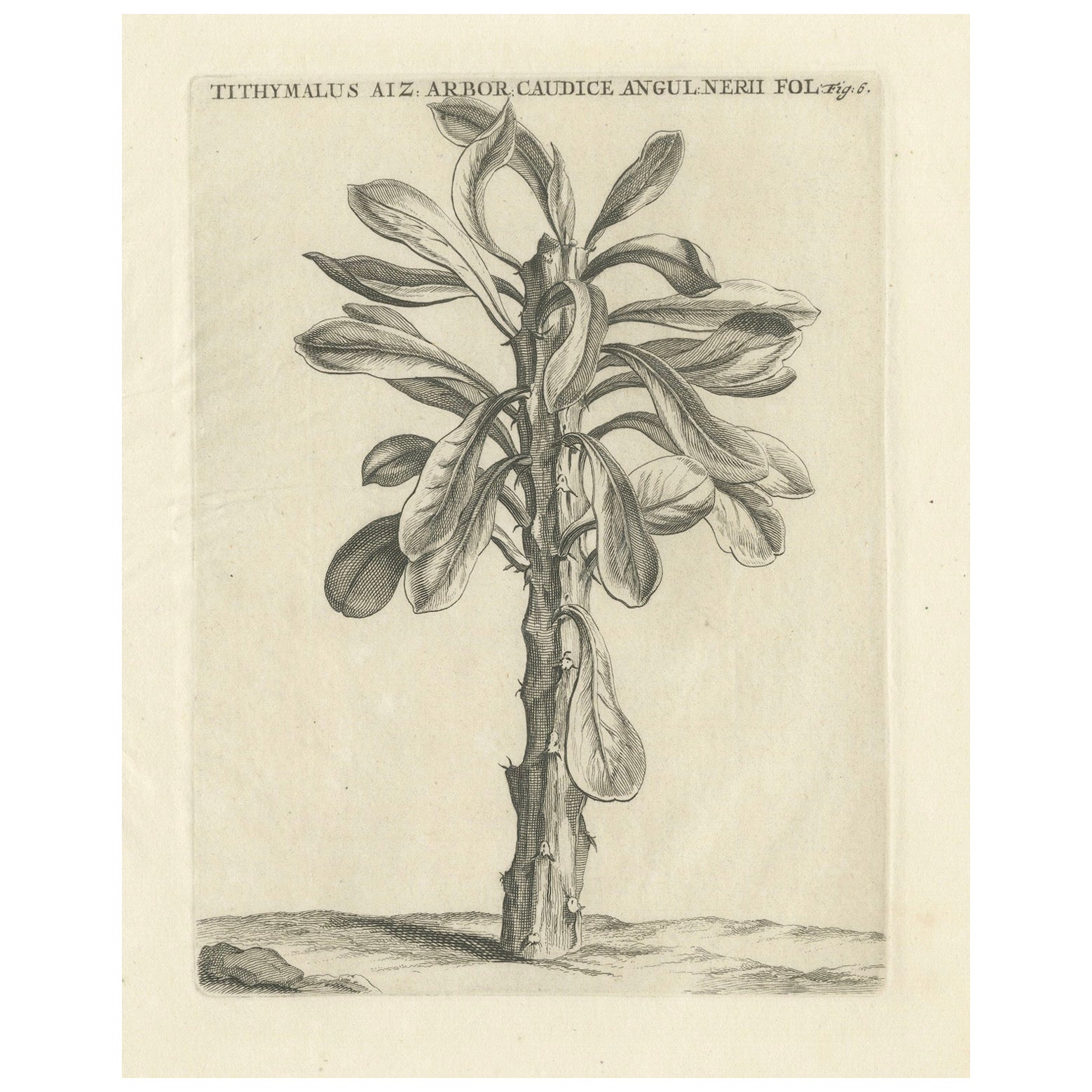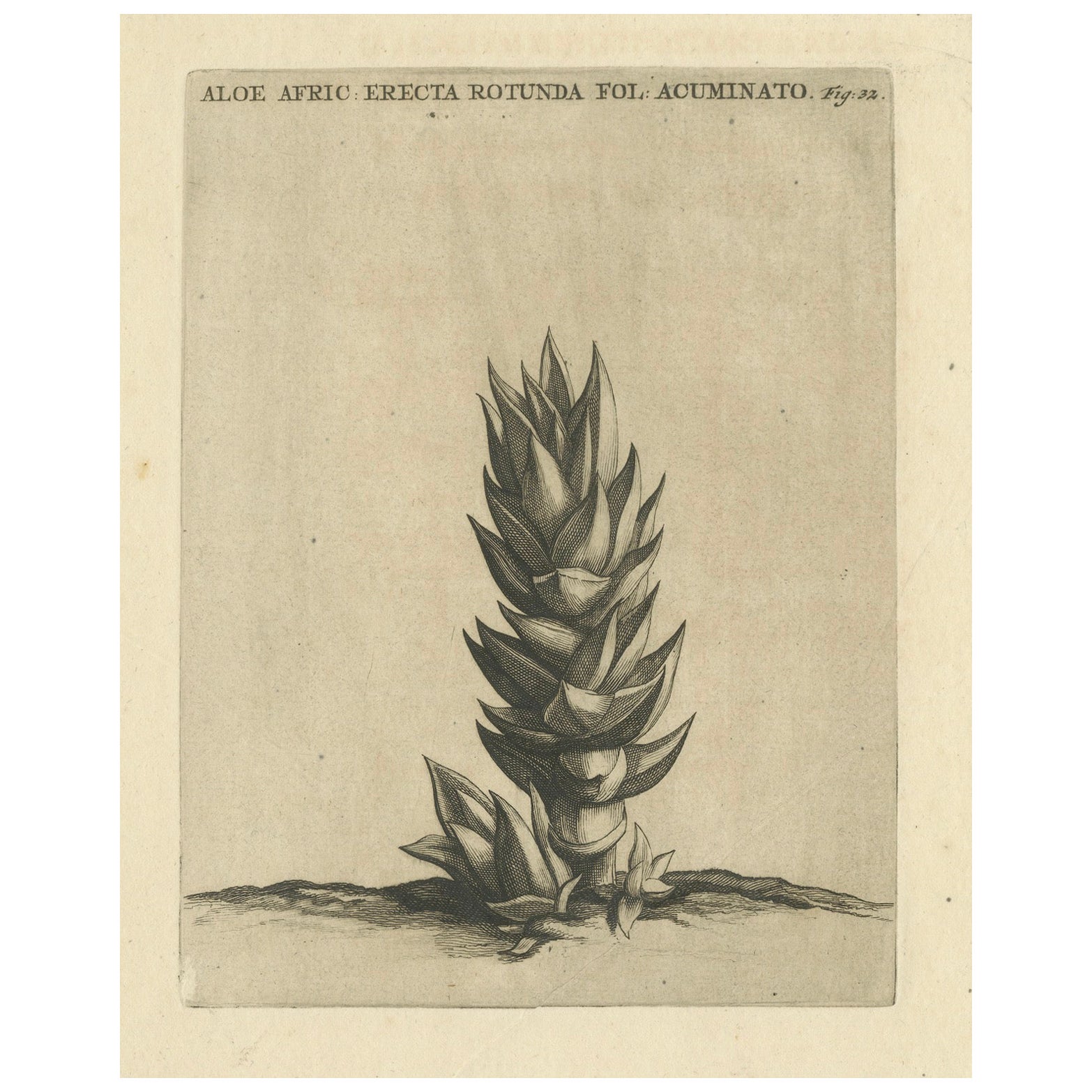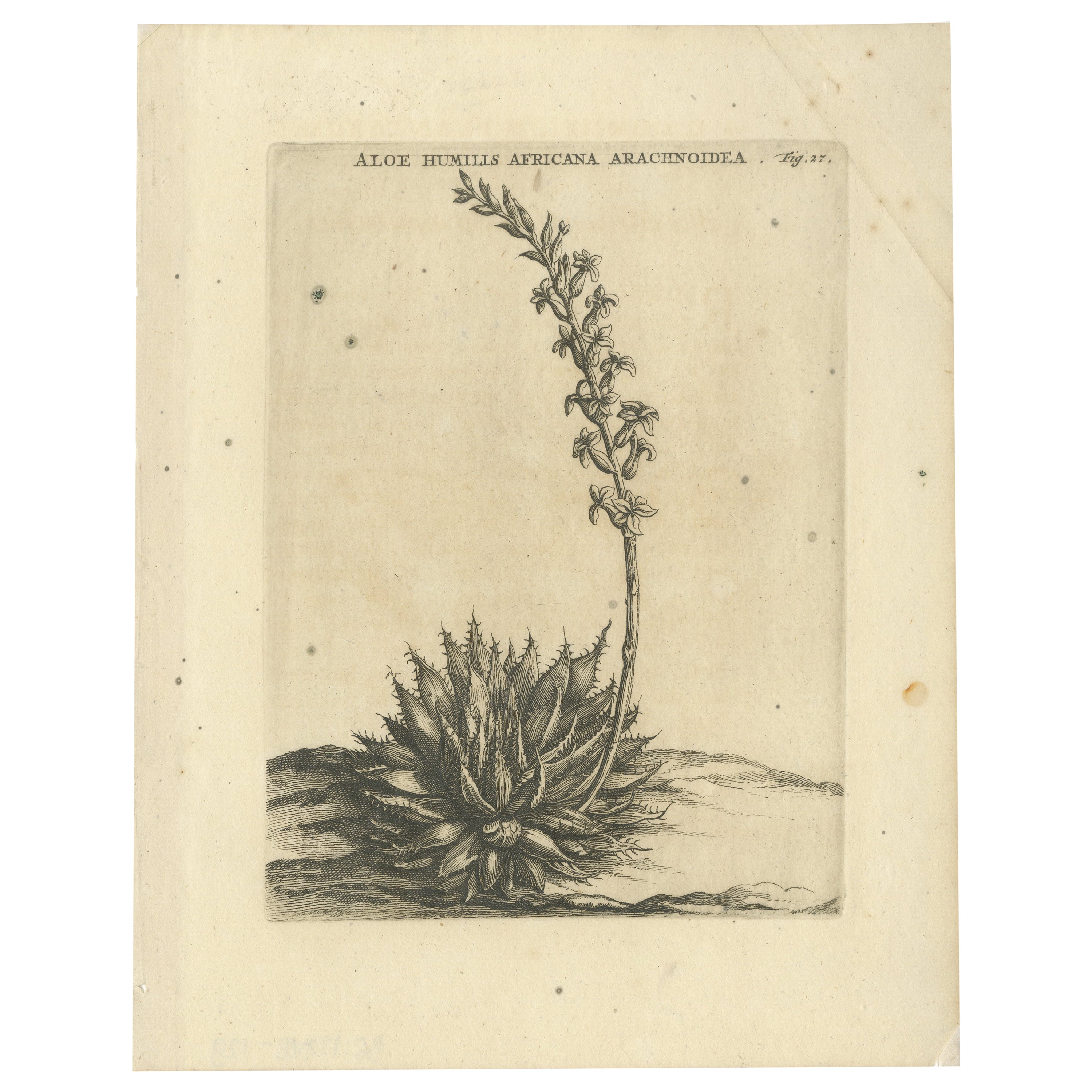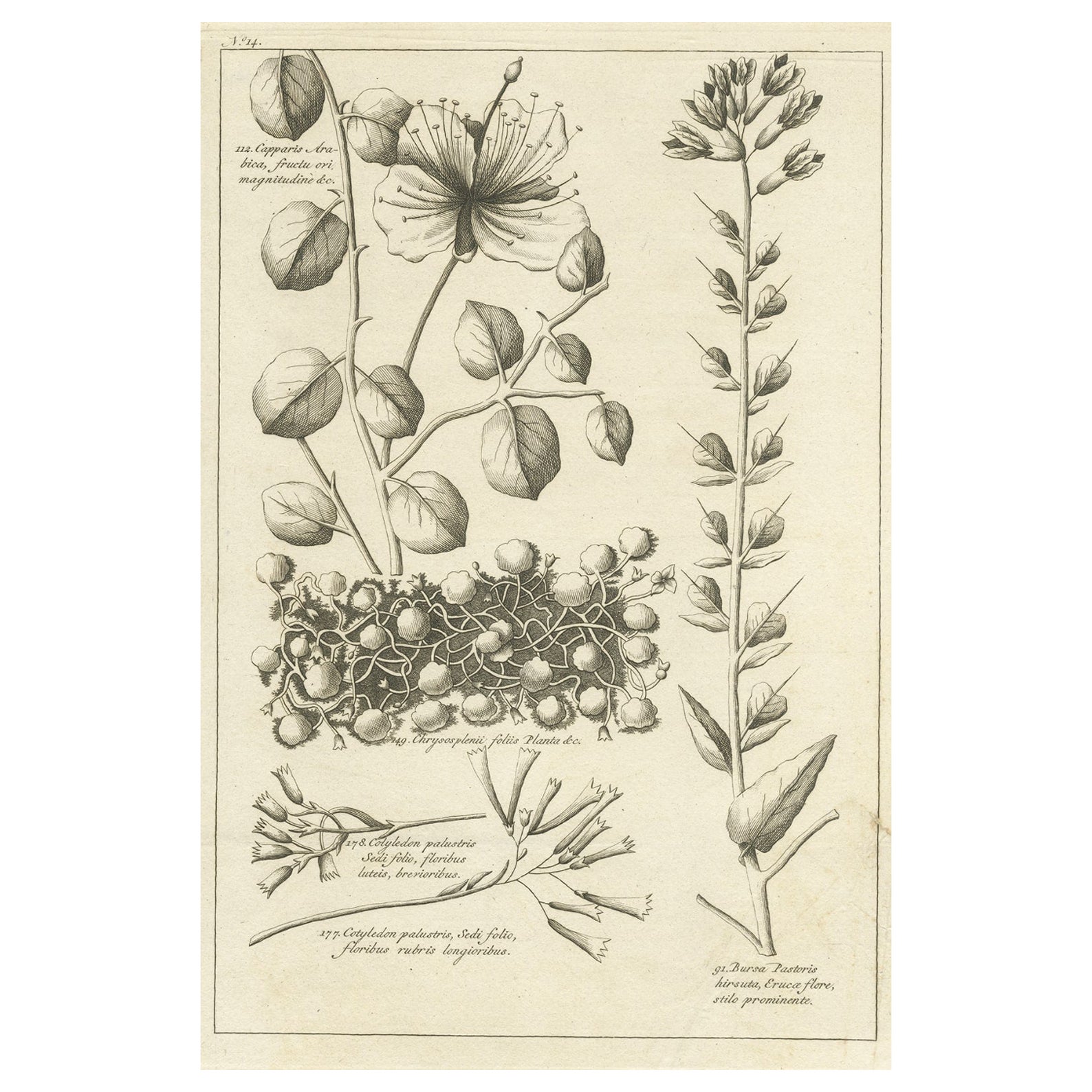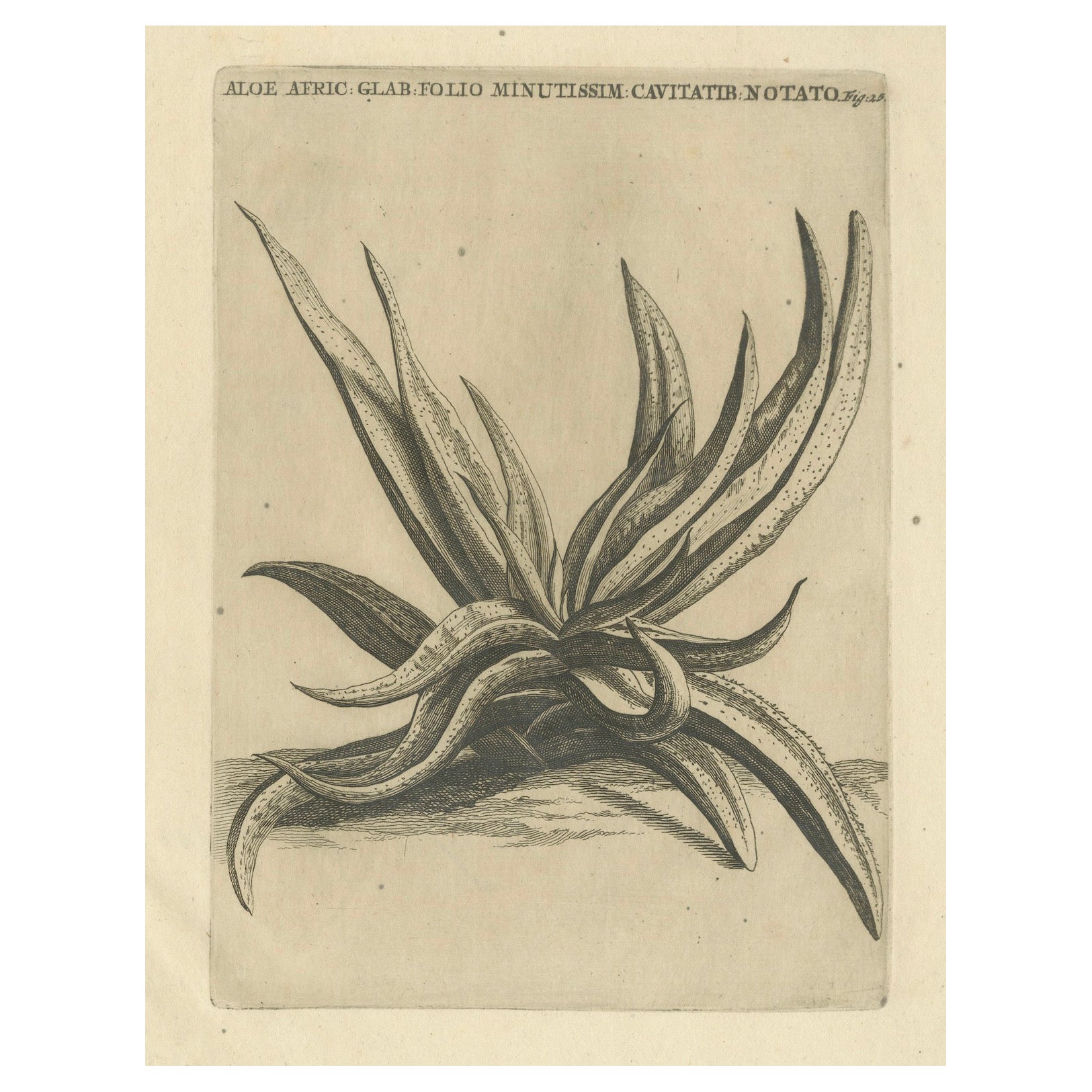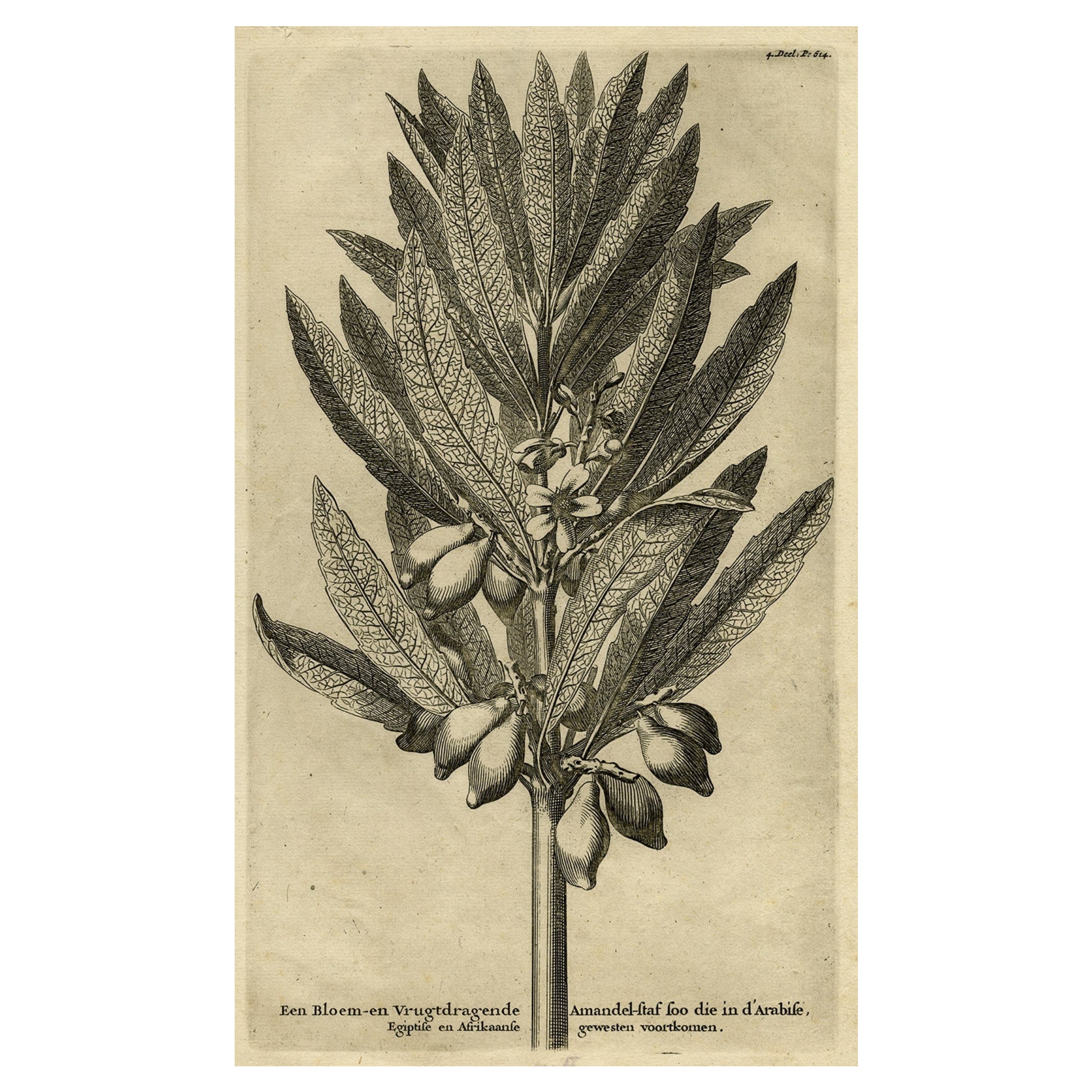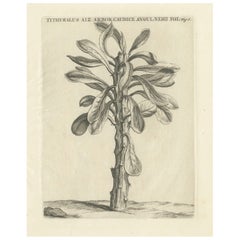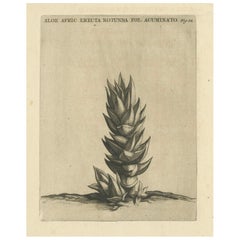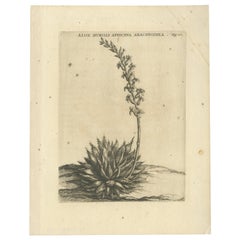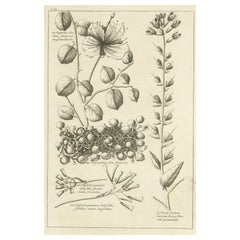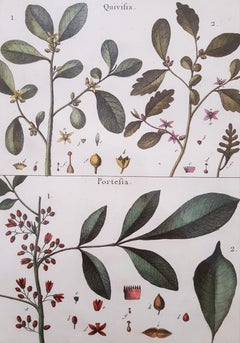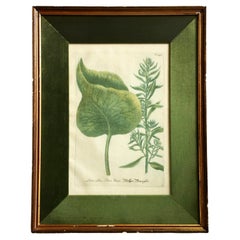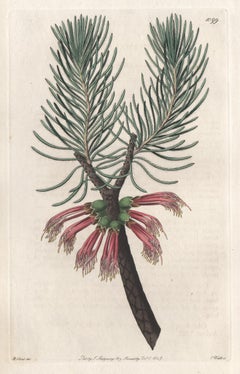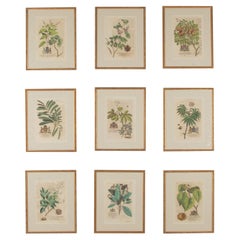Items Similar to Botanical Engraving of Alaternoides Afric Lauri Serratae from Commelin, 1706
Want more images or videos?
Request additional images or videos from the seller
1 of 11
Botanical Engraving of Alaternoides Afric Lauri Serratae from Commelin, 1706
$258.53
$344.7025% Off
£192.52
£256.7025% Off
€217.50
€29025% Off
CA$356.93
CA$475.9125% Off
A$395.71
A$527.6125% Off
CHF 207.96
CHF 277.2825% Off
MX$4,842.84
MX$6,457.1325% Off
NOK 2,597.22
NOK 3,462.9725% Off
SEK 2,437.75
SEK 3,250.3425% Off
DKK 1,655.97
DKK 2,207.9625% Off
About the Item
Botanical Engraving of Alaternoides Afric Lauri Serratae from Caspar Commelin, 1706
This engraving is possibly a botanical illustration from Caspar Commelin's *"Praeludia Botanica,"* published in 1703. It depicts **Alaternoides Afric Lauri Serratae Folio**, an African plant species with serrated, laurel-like leaves. The Latin title translates to "African Alaternoides with serrated laurel leaves."
This engraving could be a proof print (proefdruk) of Caspar Commelin's work, *"Horti Medici Amstelaedamensis Plantæ Rariores et Exoticæ ad Vivum Æri Incisæ,"* published in 1706 by Fredericum Haringh in Leiden (Lugduni Batavorum).
The style and botanical detail in the engraving align with the scientific and illustrative approach typical of the Commelins' botanical works. These illustrations were often created directly from life ("ad vivum") to document rare and exotic plants, many of which were housed at the Amsterdam Hortus Medicus.
Given that proof prints were commonly produced to ensure accuracy before inclusion in published works, this engraving may be part of the preparatory process for Commelin's publications. It fits with the layout and descriptions found in the 1706 edition of Caspar Commelin's botanical works, which continued the legacy initiated by his uncle, Jan Commelin.
### Description:
The engraving shows a plant with serrated, laurel-like leaves growing on a slender stem. The leaves are detailed with jagged edges, and the base of the plant is shown with additional botanical elements, such as seeds and a fallen leaf.
- Leaf Structure: The engraving carefully depicts the serrated edges of the leaves, highlighting their laurel-like shape. The plant's slender stem supports a dense arrangement of leaves.
- Botanical Elements: At the base of the plant, the illustration shows a fallen leaf and small seeds or fruits, providing further detail about the plant's growth and reproductive features.
### Maker:
This engraving likely belongs to the series produced under the supervision of Caspar Commelin for his botanical publications. Caspar Commelin continued the work of his uncle, Jan Commelin, documenting rare and exotic plants brought to Europe, primarily through Dutch colonial and trade networks. Their botanical works, such as *"Horti Medici Amstelaedamensis,"* were significant in early efforts to classify and describe plants from around the world.
### What It Shows:
The engraving provides a detailed depiction of Alaternoides Afric, showcasing its serrated, laurel-like leaves. The plant is likely native to Africa and was valued for its ornamental or medicinal properties. This engraving serves as an accurate scientific illustration, helping botanists and herbalists study the plant's unique characteristics.
This engraving likely contributed to European efforts in the 18th century to classify and document exotic species, focusing on their botanical features and potential uses.xotic species, focusing on their botanical features and potential uses.
- Dimensions:Height: 9.34 in (23.7 cm)Width: 7.29 in (18.5 cm)Depth: 0 in (0.02 mm)
- Materials and Techniques:Paper,Engraved
- Place of Origin:
- Period:1700-1709
- Date of Manufacture:1706
- Condition:Condition: very good, given age. Etching / engraving on hand-laid (verge) paper. Light foxing, mostly outside the plate-mark. General age-related toning and/or occasional minor defects from handling. One flattened crease. Study the scans carefully.
- Seller Location:Langweer, NL
- Reference Number:Seller: BG-13748-1311stDibs: LU3054341525942
About the Seller
5.0
Recognized Seller
These prestigious sellers are industry leaders and represent the highest echelon for item quality and design.
Platinum Seller
Premium sellers with a 4.7+ rating and 24-hour response times
Established in 2009
1stDibs seller since 2017
2,609 sales on 1stDibs
Typical response time: <1 hour
- ShippingRetrieving quote...Shipping from: Langweer, Netherlands
- Return Policy
Authenticity Guarantee
In the unlikely event there’s an issue with an item’s authenticity, contact us within 1 year for a full refund. DetailsMoney-Back Guarantee
If your item is not as described, is damaged in transit, or does not arrive, contact us within 7 days for a full refund. Details24-Hour Cancellation
You have a 24-hour grace period in which to reconsider your purchase, with no questions asked.Vetted Professional Sellers
Our world-class sellers must adhere to strict standards for service and quality, maintaining the integrity of our listings.Price-Match Guarantee
If you find that a seller listed the same item for a lower price elsewhere, we’ll match it.Trusted Global Delivery
Our best-in-class carrier network provides specialized shipping options worldwide, including custom delivery.More From This Seller
View AllBotanical Engraving of Tithymalus Aiz Arbor from Caspar Commelin’s Work, 1706
Located in Langweer, NL
Botanical Engraving of Tithymalus Aiz Arbor from Caspar Commelin’s Work, 1706
This engraving is possibly a botanical illustration from Caspar Commelin's "Praeludia Botanica," publis...
Category
Antique Early 1700s Prints
Materials
Paper
$275 Sale Price
20% Off
Botanical Engraving of Aloe Afric Erecta from Caspar Commelin's Work, 1706
Located in Langweer, NL
Botanical Engraving of Aloe Afric Erecta from Caspar Commelin's Work, 1706
This engraving is likely a botanical illustration from Caspar Commelin's "Praeludia Botanica," published i...
Category
Antique Early 1700s Prints
Materials
Paper
$275 Sale Price
20% Off
Aloe Humilis Africana Botanical Engraving from Caspar Commelin's Work, 1706
Located in Langweer, NL
Aloe Humilis Africana Botanical Engraving from Caspar Commelin's Work, 1706
This engraving is possibly a botanical illustration from Caspar Commelin's "Praeludia Botanica," publishe...
Category
Antique Early 1700s Dutch Prints
Materials
Paper
$275 Sale Price
20% Off
Antique Engraving of the Caper Bush and Other Plants, 1773
Located in Langweer, NL
Antique print titled 'Capparis Arabica (..)'. Old botany print depicting the caper bush, shepherd's purse and other plants. Originates from the first Dutch editon of an interesting t...
Category
Antique 18th Century Prints
Materials
Paper
$209 Sale Price
20% Off
Botanical Engraving of African Aloe from Commelin’s "Praeludia Botanica", 1703
Located in Langweer, NL
African Aloe Botanical Engraving from Caspar Commelin’s "Horti Medici Amstelaedamensis," 1706
This engraving is possibly a botanical illustration from Caspar Commelin's "Praeludia B...
Category
Antique Early 1700s Prints
Materials
Paper
$275 Sale Price
20% Off
Original Antique Engraving of an Almond Branch in Arabia, Egypt or Africa, 1729
Located in Langweer, NL
Antique print, titled: 'Een Bloem- en Vruchtdragende Amandel-Staf soo die in d'Arabise Egiptise en Afrikaanse gewesten voortkomen.' - ('A flower- and fruit-bearging almond Almond bra...
Category
Antique 1720s Prints
Materials
Paper
$256 Sale Price
20% Off
You May Also Like
Quivisia; Portesia /// Antique Botanical Botany Plants Science Engraving Buffon
By Georges-Louis Leclerc, Comte de Buffon
Located in Saint Augustine, FL
Artist: Georges-Louis Leclerc, Comte de Buffon (French, 1707-1788)
Title: "Quivisia; Portesia" (Octandreie, Monogynie, Plate 302)
Portfolio: Histoire Naturelle
Year: 1749-1789
Medium: Original Hand-Colored Engraving on laid paper
Limited edition: Unknown
Printer: Imprimerie Nationale, Paris, France
Publisher: Georges-Louis Leclerc, Comte de Buffon, Paris, France
Framing: Not framed, but beautifully double matted with hand decorated archival French matting...
Category
2010s Naturalistic Still-life Prints
Materials
Watercolor, Engraving, Laid Paper, Intaglio
1736-45 Framed Botanical Engraving, Johann Wilhelm Weinmann
By Johann Wilhelm Weinmann
Located in Louisville, KY
Framed Botanical Engraving, Johann Wilhelm Weinmann. Johann Wilhelm Weinmann (German 1683-1741) Published in Amsterdam & Ratisbon, 1736-45....
Category
Antique Mid-18th Century German Other Prints
Materials
Velvet, Giltwood, Paper
Calothamnus Villosa, 19th century Australian native botanical engraving print
Located in Melbourne, Victoria
'Calothamnus Villosa - Villous Calothamnus'
Original engraving with original hand-colouring by S Watts After M Hart, 1827.
Native plant of Australia.
...
Category
Early 19th Century Naturalistic Still-life Prints
Materials
Engraving
Collection of Nine 18th Century Tropical Botanical Engravings by Georg Dionysius
By Georg Dionysius Ehret
Located in Tetbury, Gloucestershire
Collection of nine 18th Century tropical botanical engravings by Georg Dionysius Ehret.
Hand coloured prints depicting local flora of Barbados. Each is dedicated to a prominent perso...
Category
Antique 18th Century German Prints
Materials
Paper
Jan & Caspar Commelin: 17th Century Botanical Engravings, 1st Edition
By Jan & Caspar Commelin
Located in Richmond, GB
""Horti Medici Amstelodamensis Rariorum"" (Rarities of the Amsterdam Physic Garden),
1st edition, 1697 - 1701. ( Ref: Dunthorne: 81)
Jan Commelin (1629-1692) was Director of the Am...
Category
17th Century Paintings
Materials
Silver
Citamerdu (Amrita) Plant: 17th Century Botanical Engraving by Hendrik van Rheede
Located in Alamo, CA
This is a rare 17th century engraving of a plant entitled "Citamerdu" by the Dutch botanist Hendrik van Rheede tot Drakenstein, plate 21 from his 'Hortus Indicus Malabaricus' (Garden of Malabar), published in Amsterdam in 1686 by Johann van Someren. The engraving depicts the Citamerdu plant, also known as Tinospora cordifolia plant or Amrita and Guduchi. It is a deciduous plant with heart-shaped leaves, greenish flowers, and pea-shaped fruits. Rheede's 19th century publication featured illustrations of exotic plants and fruits labelled with script in the upper right corner in Latin, Malay, Arabic, and Sanskrit. Hortus Indicus Malabaricus is believed to be the earliest comprehensive published work on the flora of Asia and the tropics. The 17th century treatise featured important illustrations of 740 plants of the region, including Indian medicinal plants.
The engraving is printed on 17th century laid, chain-linked paper, watermarked with an elaborate crown design. The sheet measures 15.75" high by 18.75" wide. There is a central fold, as issued. There are a few small spots, but the print is otherwise in excellent condition.
There are additional Rheede botanical engravings from his 'Hortus Indicus Malabaricus' publication that are listed on my 1stdibs storefront and online website. These would make for an impressive display grouping. A discount is available for purchase of two or more of the prints.
Hendrik Adriaan van...
Category
Late 17th Century Naturalistic Landscape Prints
Materials
Engraving
More Ways To Browse
English Iron Bed
Franz Xavier Bergman
Frem Rojle Chair
French Confit Jar
French Opaline Bottle
French Soda
Garden Rabbit
German Cigarette Case
Gio Ponti Display Cabinet
Glass Door Etagere
Glass Ginger Jar
Goat Skin Parchment
Goryeo Celadon
Granite Buddha
Gun Cabinet
Hand Painted Music Boxes
Hay Dining Table
Italian Topiary
